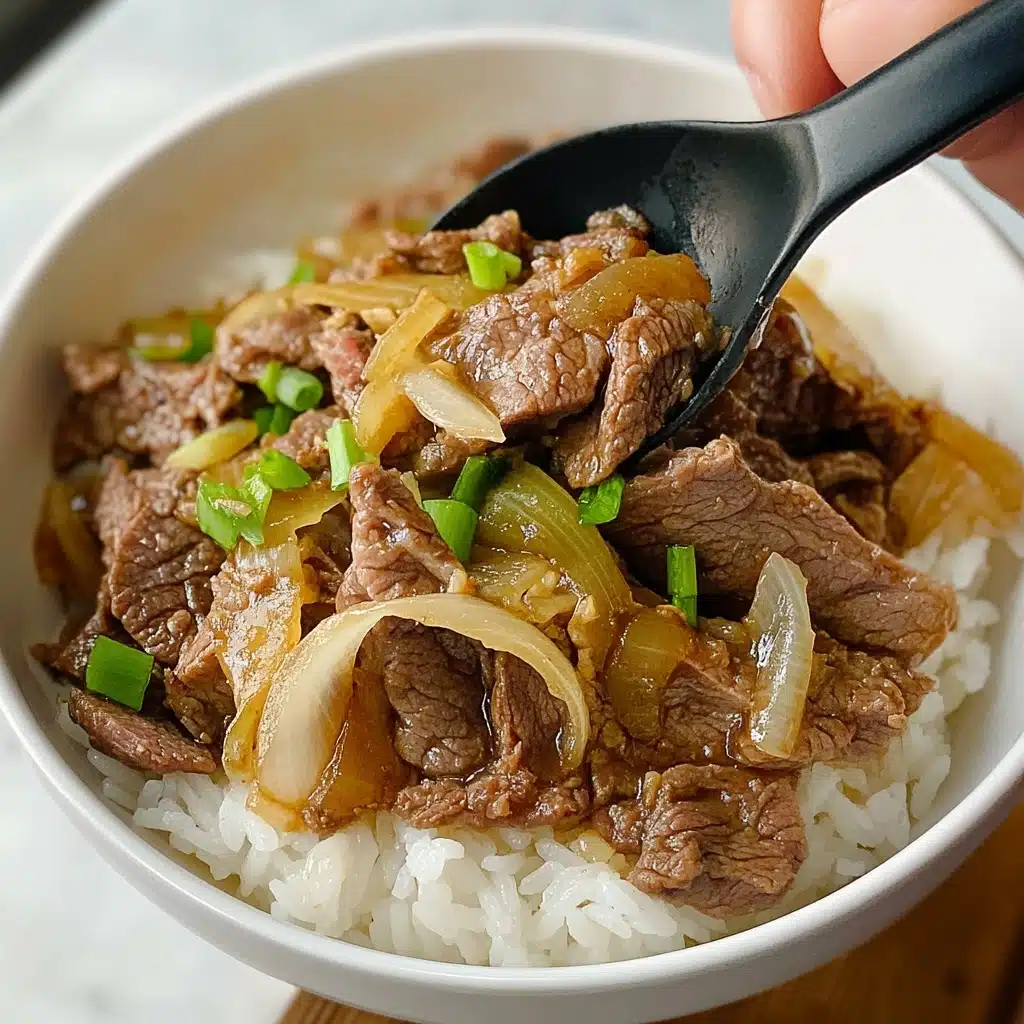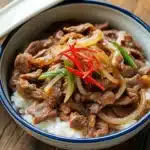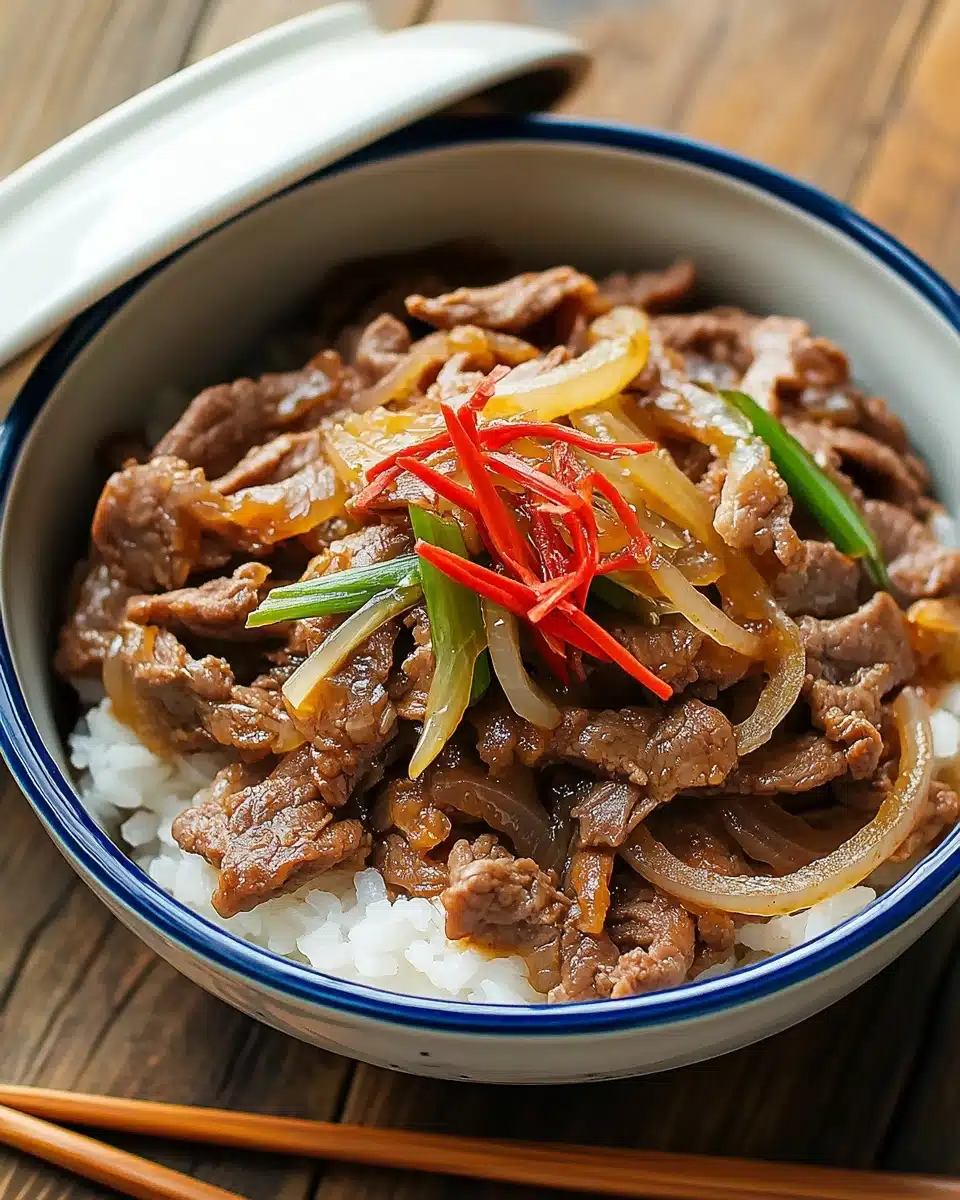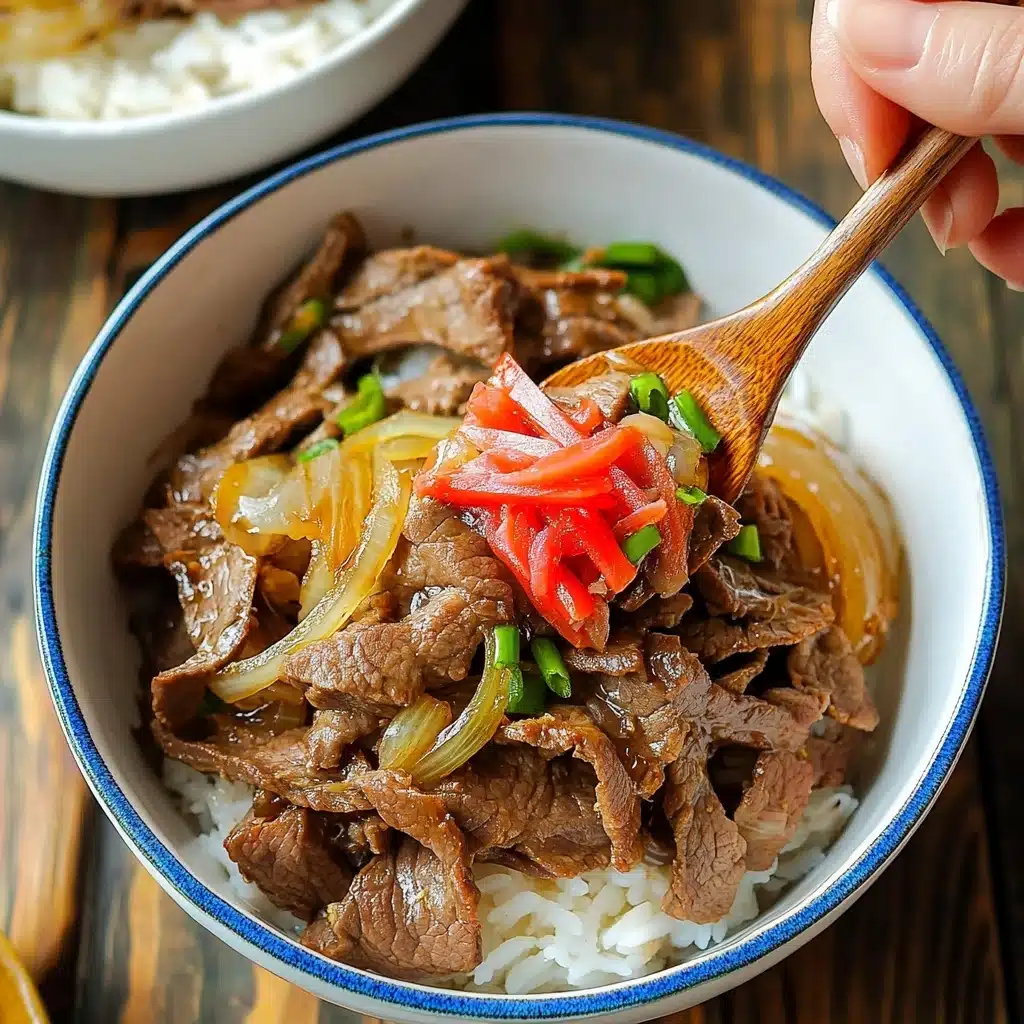If you’ve been craving a comforting, quick, and oh-so-flavorful Japanese meal, let me introduce you to my favorite Gyudon (Japanese Beef Rice Bowl) recipe. I absolutely love how this dish brings everything together – tender, thinly sliced beef simmered in a savory-sweet broth over fluffy rice. It’s one of those recipes that works perfectly for busy weeknights or anytime you want a satisfying meal with minimal fuss.
When I first tried making Gyudon at home, I was amazed by how simple ingredients come alive with just the right balance of dashi, soy sauce, and mirin. You’ll find that this Gyudon (Japanese Beef Rice Bowl) recipe is not only authentic but also incredibly adaptable – perfect for beginners, yet rewarding enough for seasoned cooks looking for a comforting Japanese classic.
Why You’ll Love This Recipe
- Quick and Easy: From prep to plate in about 20 minutes, it’s perfect for busy days.
- Authentic Flavor: Uses classic Japanese ingredients like dashi and mirin for true-to-the-source taste.
- Versatile and Adaptable: You can tweak the ingredients and toppings to suit your preferences and pantry.
- Family Favorite: My family goes crazy for this comforting bowl—it’s often requested again and again!
Ingredients You’ll Need
The beauty of this Gyudon (Japanese Beef Rice Bowl) recipe lies in its simplicity; every ingredient plays an essential part, especially the dashi which creates that deep umami base. I always recommend sourcing fresh, thinly sliced beef and quality mirin to make sure your dish shines through.
- Onion: Slicing it thin ensures it cooks evenly and blends seamlessly with the broth’s sweetness.
- Green onion/scallion: Adds a burst of fresh, sharp flavor and crisp texture at the end.
- Thinly sliced beef (ribeye preferred): I freeze the beef slightly before slicing; it makes handling much easier and the slices more precise.
- Dashi (Japanese soup stock): The magic behind that authentic umami flavor — you can use packets or powder for convenience.
- Sake: Adds a subtle depth—if you don’t have it, dry sherry or a splash of water work too.
- Mirin: This sweet rice wine balances the salty soy sauce perfectly.
- Soy sauce: The backbone of the savory flavor, be sure to pick a good quality one.
- Sugar: Just enough to round out the flavors without overwhelming the dish.
- Short-grain Japanese rice: Sticky rice is key to getting that authentic donburi feel.
- Pickled red ginger (beni shoga): It’s a vibrant garnish that cuts through the richness and adds a pop of color.
Variations
I love experimenting with Gyudon and encourage you to make it your own. Whether you want it lighter, richer, or with a twist, the base recipe is super flexible and forgiving.
- With Egg: Adding beaten egg during the last minute of cooking makes the dish creamier—my family adores this for breakfast-style bowls.
- Vegetarian Version: Swap dashi with vegan dashi and replace beef with mushrooms for an earthy flavor.
- Spicy Kick: Try mixing in a bit of chili oil or shichimi togarashi to the sauce for some heat.
- Extra Veggies: Add shredded carrots or sliced shiitake mushrooms for extra texture and nutrition.
How to Make Gyudon (Japanese Beef Rice Bowl) Recipe
Step 1: Prepare Your Ingredients
Start by thinly slicing half an onion so it cooks quickly and blends beautifully into the sauce. Then, slice your green onion diagonally into thin rounds for that fresh punch at the end. For the beef, I like to partially freeze it for about 10 minutes to make slicing easier; then cut into roughly 3-inch wide pieces, perfect for quick cooking and tender bites.
Step 2: Combine Sauce and Simmer
In a large, unheated frying pan, mix your dashi, sake, mirin, soy sauce, and sugar. Stir gently until the sugar dissolves completely — this is key to a smooth sauce. Spread the onions evenly in the pan, separating layers so they cook evenly, then layer the beef on top. Don’t mix; just spread the meat out so it covers the onions without overcrowding.
Step 3: Cook Covered and Simmer
Cover the pan and turn the heat to medium. Once it starts simmering, lower the heat and keep it at a gentle simmer for about 3-4 minutes, letting the flavors meld beautifully. Keep an eye out and occasionally skim the foam or fat that rises to the top—the trick I learned early on to keep the broth clear and clean tasting.
Step 4: Add Green Onions and Optional Egg
Sprinkle the sliced green onions over the top, then cover again for another minute to soften them slightly. If you want to try the egg variation, now’s the time to drizzle beaten egg gently over the simmering beef without stirring. Cover and cook until the egg is just set but still tender, adding a silky texture that’s unforgettable.
Step 5: Serve Over Rice and Garnish
Scoop freshly cooked short-grain rice into your bowls and ladle some of the flavorful sauce on top. Then pile on the tender beef and onions, drizzle with extra pan sauce if you like, and finish with that bright zing of pickled red ginger. This finishing touch always lifts the dish and keeps you coming back for more.
Pro Tips for Making Gyudon (Japanese Beef Rice Bowl) Recipe
- Freeze Beef Slightly: It’s so much easier to slice and gives you those beautiful thin strips that cook perfectly fast.
- Skim the Broth: I learned that removing foam and fat while simmering keeps the sauce clean and enhances the flavor.
- Don’t Overcrowd the Pan: Spreading out the beef and onions lets everything cook evenly, so nothing gets steamed instead of simmered.
- Use Quality Dashi: This is the secret umami base—invest in a good dashi powder or stock for the best flavor.
How to Serve Gyudon (Japanese Beef Rice Bowl) Recipe

Garnishes
I always top my Gyudon with pickled red ginger – it adds a lovely tang and bright color contrast that cuts through the richness of the beef. Sometimes I also sprinkle a pinch of shichimi togarashi (Japanese seven-spice) when I’m craving a little heat. A few thin slices of fresh green onion on top add crunch and freshness that balances the dish beautifully.
Side Dishes
This Gyudon pairs wonderfully with a simple miso soup and a small side of steamed or pickled vegetables like cucumber sunomono or edamame. My go-to is light Japanese salads dressed with sesame or ginger dressing to round out the meal. These sides keep the meal balanced and let the rich beef bowl shine as the centerpiece.
Creative Ways to Present
For special occasions, I like to serve Gyudon in beautiful donburi bowls and garnish with edible flowers or a drizzle of spicy mayo for the extra wow factor. Stacking the beef attractively with a neat mound of rice underneath always makes it look restaurant-worthy. Wrapping a sushi mat around the bowl for presentation gives it a fun, authentic touch when serving guests.
Make Ahead and Storage
Storing Leftovers
I store leftover beef and onion mixture in an airtight container in the fridge, and it keeps wonderfully for 2-3 days. Just make sure to cool it before sealing the container to keep flavors fresh. When cooking for two, it’s wonderful to have leftovers for a quick lunch the next day.
Freezing
Freezing works well with this Gyudon beef sauce mix — I divide it into meal-sized portions and freeze in freezer-safe containers. Just thaw overnight in the fridge for best results. I’ve found that freezing doesn’t compromise the tenderness of the beef, which means you can enjoy your Gyudon any time without extra prep.
Reheating
To reheat, I usually warm the beef mixture gently on the stovetop with a splash of water or dashi to loosen up the sauce. This helps maintain its silky texture and avoids drying out the beef. Reheat the rice separately and then assemble your bowl fresh for best taste and texture.
FAQs
-
Can I use other cuts of beef for Gyudon?
Yes! While ribeye or thinly sliced beef is traditional and cooks quickly, you can also use sirloin or even flank steak if sliced super thin. Just be mindful that thicker cuts may take longer to cook and could be less tender.
-
What if I don’t have dashi?
Dashi is the umami heart of this recipe, but if you can’t find it, you can use a mix of beef or chicken broth with a bit of soy sauce and kombu seaweed for some depth. There are also instant dashi powders widely available that make prep quick and easy.
-
Is Gyudon traditionally served with rice?
Absolutely! Gyudon literally means “beef bowl,” and serving it over fluffy Japanese short-grain rice is essential for the authentic experience. The rice helps soak up all those delicious savory-sweet juices.
-
Can I prepare Gyudon without alcohol?
Definitely. You can substitute sake and mirin with water plus a bit of sugar to maintain balance in the sauce. While some depth might be missing, the dish still tastes delicious and authentic.
-
How thin should the beef be sliced for Gyudon?
Beef should be sliced paper-thin — about 1-2 mm if possible — so it cooks quickly and stays tender. Partially freezing the beef makes it much easier to achieve these thin slices.
Final Thoughts
I’ll always have a soft spot for this Gyudon (Japanese Beef Rice Bowl) recipe because it reminds me of cozy dinners after long days and sharing something comforting with loved ones. It’s one of those magic bowls where simple ingredients combine into something greater than the sum of their parts. Give this recipe a try—you might find it becomes your go-to comfort dish, too. Trust me, once you’ve made it, you’ll understand why my family asks for it over and over again!
Print
Gyudon (Japanese Beef Rice Bowl) Recipe
- Prep Time: 5 minutes
- Cook Time: 15 minutes
- Total Time: 20 minutes
- Yield: 2 servings
- Category: Main Dish
- Method: Stovetop
- Cuisine: Japanese
Description
Gyudon is a classic Japanese beef rice bowl featuring thinly sliced beef and onions simmered in a savory dashi-based sauce with sake, mirin, soy sauce, and sugar. Served over steamed Japanese short-grain rice and garnished with pickled red ginger, this comforting dish is quick to prepare and perfect for a hearty meal.
Ingredients
Main Ingredients
- 1/2 onion (4 oz, 113 g), thinly sliced
- 1 green onion/scallion, sliced diagonally
- 1/2 lb thinly sliced beef (such as ribeye), cut into 3-inch pieces
Sauce
- 1/2 cup dashi (Japanese soup stock; Awase Dashi, dashi packet or powder, or Vegan Dashi)
- 2 Tbsp sake (or substitute with dry sherry, Chinese rice wine, or water for non-alcohol version)
- 2 Tbsp mirin (or use 2 Tbsp sake/water + 2 tsp sugar)
- 3 Tbsp soy sauce
- 1 Tbsp sugar (adjust to taste)
For Serving
- 2 servings cooked Japanese short-grain rice (about 1 2/3 cups / 250 g per serving)
- Pickled red ginger (beni shoga or kizami beni shoga), for garnish
Instructions
- Prepare Ingredients: Thinly slice the onion and diagonally slice the green onion/scallion. Cut the semi-frozen beef into 3-inch wide pieces to ensure tenderness and ease of cooking.
- Make the Sauce and Combine: In a large frying pan (unheated), combine the dashi, sake, mirin, soy sauce, and sugar. Stir well to dissolve the sugar completely.
- Add Onion and Beef: Spread the sliced onions evenly in the broth in the pan, separating the layers. Distribute the sliced beef on top, separating the slices so the meat fully covers the onions.
- Simmer: Cover the pan with a lid, turn heat to medium, and bring to a simmer. Once simmering, reduce heat to low and cook covered for 3–4 minutes, allowing flavors to meld and beef to cook through.
- Skim Fat and Add Green Onions: While simmering, occasionally lift the lid to skim off any scum or excess fat with a fine-mesh skimmer. Sprinkle the green onions on top and cook for an additional minute, covered.
- Serve: Place cooked Japanese short-grain rice into individual bowls. Drizzle some pan sauce over the rice, then top with the beef and onion mixture. Add extra sauce if desired and garnish with pickled red ginger. Enjoy immediately.
- Storage: Store any leftover beef mixture in an airtight container in the refrigerator for 2–3 days or freeze for 3–4 weeks.
Notes
- For a Kansai-style variation, stir-fry onions first with a tablespoon of oil, then add beef and sugar, followed by sake, mirin, and soy sauce, cooking until beef is no longer pink.
- Optional beaten eggs can be added near the end of cooking by drizzling them over the beef and cooking until just set.
- Using semi-frozen beef makes slicing easier and helps maintain meat texture.
- Adjust sugar in sauce to taste depending on desired sweetness.
- To reduce alcohol content, substitute sake and mirin with water and extra sugar as noted.









